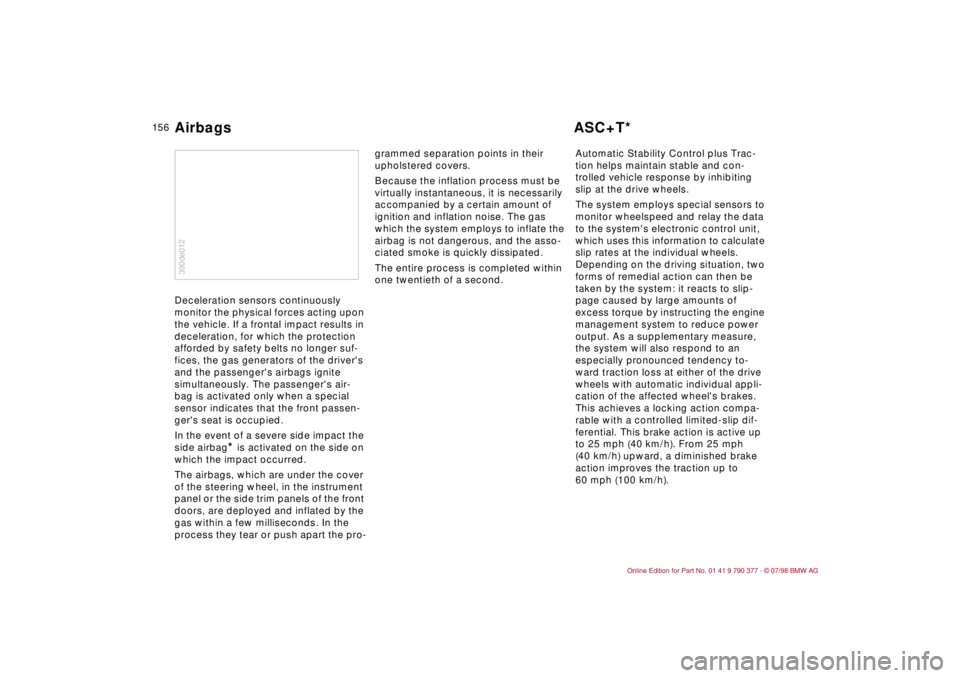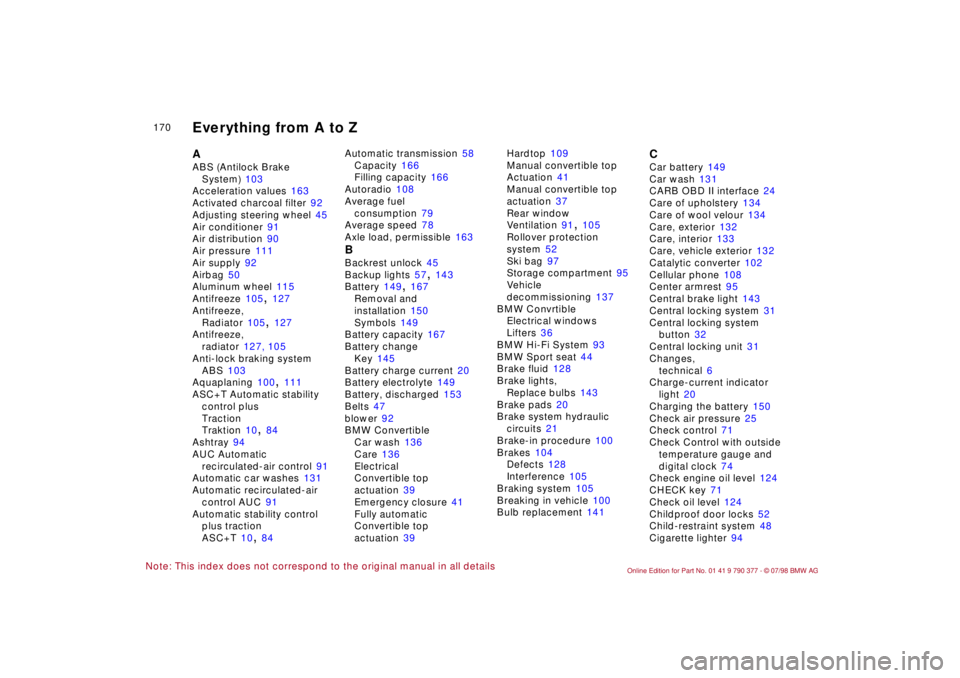1998 BMW CONVERTIBLE belt
[x] Cancel search: beltPage 135 of 179

13 4
The safety belts should be cleaned with
a mild soap and water solution without
being removed from the car. Never
attempt chemical or dry cleaning, as
damage to the belt fabric could result.
After cleaning, never allow the inertia
reel to retract the belts until they are
completely dry. Dirty safety belts pre-
vent the inertia reel mechanism from
retracting the strap properly, and thus
constitute a safety hazard.
Heavily soiled floor carpets and mats
*
can be cleaned with an interior cleaner.
The floor mats can be removed from the
vehicle for cleaning.
Please use only a damp cloth to clean
wooden fascia panels and components.
Follow up by drying with a soft cloth.
b
Products for cleaning and care are
available from your BMW Retailer.c
Care of upholstery materialsDepressions resulting in the upholstered
materials in the course of everyday use
can be brushed up by brushing with a
lightly dampened brush "against the
nap".
The tendency of the pile to lie in a par-
ticular direction on velour upholstery is
not a quality defect, and, just as on
home textiles or clothing, can not be
avoided.
Fuzz on upholstery materials, rubbed-in
fabric or suede residues can be removed
with a fuzz or Velcro
â brush. A cleaning
glove is available for particularly "stub-
born" fuzz. Stains and fairly large areas
of dirt should be cleaned off without
delay, using lukewarm water and an
interior cleaner, stain remover or clean-
ing-grade benzene. Brush the fabric
afterwards to restore its appearance.
If the upholstery is to be exposed to
intense sunlight or if the vehicle is to be
stored for an extended period, cover all
seats to prevent fading.
b
A full range of car-care products is
available from your BMW Retailer.cThe build-up of an electrostatic charge
on the seat covers, particularly if atmo-
spheric humidity is low, can give the
occupants an unpleasant electric shock
if they touch metal body parts after
leaving the vehicle. Although this is not
dangerous in any way, it can be
avoided by touching a bare or polished
metal part of the car while getting out.
If necessary, anti-static products can
be used to eliminate this effect to a
large extent.
Caring for your car
Page 156 of 179

At a glance
Controls and featuresCare and maintenanceAdvanced technology
Technical data
Owner service procedure
At a glanceControls Car careRepairsTechnicalDataIndex
Index
15 5
Airbags156
Automatic Stability Control
plus Traction (ASC+T)156
Radio reception157
Safety belt tensioner157
Page 157 of 179

15 6
Deceleration sensors continuously
monitor the physical forces acting upon
the vehicle. If a frontal impact results in
deceleration, for which the protection
afforded by safety belts no longer suf-
fices, the gas generators of the driver's
and the passenger's airbags ignite
simultaneously. The passenger's air-
bag is activated only when a special
sensor indicates that the front passen-
ger's seat is occupied.
In the event of a severe side impact the
side airbag
* is activated on the side on
which the impact occurred.
The airbags, which are under the cover
of the steering wheel, in the instrument
panel or the side trim panels of the front
doors, are deployed and inflated by the
gas within a few milliseconds. In the
process they tear or push apart the pro-grammed separation points in their
upholstered covers.
Because the inflation process must be
virtually instantaneous, it is necessarily
accompanied by a certain amount of
ignition and inflation noise. The gas
which the system employs to inflate the
airbag is not dangerous, and the asso-
ciated smoke is quickly dissipated.
The entire process is completed within
one twentieth of a second.Automatic Stability Control plus Trac-
tion helps maintain stable and con-
trolled vehicle response by inhibiting
slip at the drive wheels.
The system employs special sensors to
monitor wheelspeed and relay the data
to the system's electronic control unit,
which uses this information to calculate
slip rates at the individual wheels.
Depending on the driving situation, two
forms of remedial action can then be
taken by the system: it reacts to slip-
page caused by large amounts of
excess torque by instructing the engine
management system to reduce power
output. As a supplementary measure,
the system will also respond to an
especially pronounced tendency to-
ward traction loss at either of the drive
wheels with automatic individual appli-
cation of the affected wheel's brakes.
This achieves a locking action compa-
rable with a controlled limited-slip dif-
ferential. This brake action is active up
to 25 mph (40 km/h). From 25 mph
(40 km/h) upward, a diminished brake
action improves the traction up to
60 mph (100 km/h).
390de012Airbags ASC+T*
Page 158 of 179

15 7
At a glanceControls Car careRepairsTechnicalDataIndex
AM provides substantially longer recep-
tion ranges than FM. AM broadcast sig-
nals, propagated at ground level in the
form of surface waves, are also reßected
from the ionosphere as atmospheric
waves.
Frequency-modulation (FM) provides
substantially better sound quality than
AM. However, because FM transmis-
sions rely on line-of-sight broadcast
waves, their effective reception range is
limited. Although numerous factors combine to
impose inherent limitations on the
reception quality available from mobile
radios, specially designed systems can
be employed to minimize their effects:
The Antenna Diversity system employs
several FM antennas integrated within
the rear window to provide three sepa-
rate sources for receiving broadcast
waves. An integral processor automati-
cally selects the antenna with the best
FM reception quality at any given time.
Because the ongoing antenna selection
process is completed within millisec-
onds, it remains inaudible to the radio
listener. The safety belt tensioner responds to
collisions by tightening the belts to
ensure that occupants remain firmly
positioned in their seats. A gas-pres-
sure system retracts the buckle assem-
bly to tension the shoulder and lap belts
within fractions of a second, preventing
the driver and passenger from slipping
forward.360de084
390de108
Radio reception Safety belt tensioner
Page 160 of 179

At a glance
Controls and featuresCare and maintenanceAdvanced technology
Technical data
Owner service procedure
At a glanceControls Car careRepairsTechnicalDataIndex
Index
15 9
Engine specifications 160
Dimensions 161
Weights 163
Capacities 166
Electrical system 167
Drive belts 167
Page 168 of 179

At a glanceControls Car careRepairsTechnicalDataIndex
16 7
BatteryBMW 318i, 318is 12 V, 65 Ah
BMW 323i, 323is,
328i, 328is 12 V, 75 Ah
BMW Convertible 12 V, 70 AhSpark plugsDual electrode:
Bosch F7 L DC R or
NGK BKR 6 EK
AC generator - Water pump -
Power steering BMW 318i, 318is
Ribbed V-belt 6 PK x 1733
BMW 323i, 323is, 328i, 328is
Ribbed V-belt 6 PK x 1555Air conditioning compressorBMW 318i, 318is
Ribbed V-belt 4 PK x 889
BMW 323i, 323is, 328i, 328is
Ribbed V-belt 5 PK x 906
Electrical system Drive belts
Page 171 of 179

170
Note: This index does not correspond to the original manual in all details
AABS (Antilock Brake
System)
103
Acceleration values
163
Activated charcoal filter
92
Adjusting steering wheel 45
Air conditioner
91
Air distribution 90
Air pressure
111
Air supply
92
Airbag
50
Aluminum wheel
115
Antifreeze
105
, 127
Antifreeze,
Radiator
105
, 127
Antifreeze,
radiator
127, 105
Anti-lock braking system
ABS
103
Aquaplaning
100
, 111
ASC+T Automatic stability
control plus
Traction
Traktion
10
, 84
Ashtray
94
AUC Automatic
recirculated-air control
91
Automatic car washes
131
Automatic recirculated-air
control AUC
91
Automatic stability control
plus traction
ASC+T
10
, 84Automatic transmission
58
Capacity
166
Filling capacity
166
Autoradio
108
Average fuel
consumption
79
Average speed 78
Axle load, permissible
163
BBackrest unlock
45
Backup lights
57
, 143
Battery
149
, 167
Removal and
installation 150
Symbols
149
Battery capacity
167
Battery change
Key
145
Battery charge current
20
Battery electrolyte
149
Battery, discharged 153
Belts
47
blower 92
BMW Convertible
Car wash
136
Care
136
Electrical
Convertible top
actuation
39
Emergency closure
41
Fully automatic
Convertible top
actuation
39Hardtop
109
Manual convertible top
Actuation 41
Manual convertible top
actuation 37
Rear window
Ventilation 91
, 105
Rollover protection
system
52
Ski bag 97
Storage compartment
95
Vehicle
decommissioning
137
BMW Convrtible
Electrical windows
Lifters
36
BMW Hi-Fi System
93
BMW Sport seat
44
Brake fluid
128
Brake lights,
Replace bulbs
143
Brake pads
20
Brake system hydraulic
circuits
21
Brake-in procedure
100
Brakes
104
Defects 128
Interference
105
Braking system 105
Breaking in vehicle
100
Bulb replacement 141
CCar battery
149
Car wash
131
CARB OBD II interface
24
Care of upholstery
134
Care of wool velour 134
Care, exterior
132
Care, interior 133
Care, vehicle exterior
132
Catalytic converter
102
Cellular phone
108
Center armrest 95
Central brake light
143
Central locking system
31
Central locking system
button
32
Central locking unit
31
Changes,
technical
6
Charge-current indicator
light
20
Charging the battery
150
Check air pressure
25
Check control
71
Check Control with outside
temperature gauge and
digital clock 74
Check engine oil level
124
CHECK key
71
Check oil level 124
Childproof door locks
52
Child-restraint system 48
Cigarette lighter
94
Everything from A to Z
Page 172 of 179

171
At a glanceControls Car careRepairsTechnicalDataIndex
Note: This index does not correspond to the original manual in all detailsClock
66
, 67
, 68
, 69
Cockpit
16
Coinbox 94
Computer 77
, 78
, 79
, 80
,
81
, 82
, 83
Consumption display
64
Convenient closure
31
Convertible, refer to BMW
convertible
Coolant
105
, 127
, 166
Coolant, Antifreeze 105
Cooling system
166
Cruise control 62
Cruising range 79
Cup holder
94
DDashboard
16
Dashboard lighting
85
Data
Dimensions
161
Engine
160
Road performance
163
Weights
163
Data, technical
160
Date
68
, 72
, 74
Daytime light switch
85
Decommissioning of the
Vehicle
137
Deep water 101
Defrost windshields
91
Defrost, windshields 91
Defrosting position 91
DieselInjection system
19
Interference
19
Digital clock
66
, 67
, 68
, 69
Dimensions
161
Dipstik, engine oil
124
Disc brakes
104
Disconnect the battery
150
Display lighting
85
Distance, remaining
79
Door keys
30
Door locks 31
Doors, emergency actuation
31
Drive belts
167
Driver's airbag
50
Driving hints
100
Driving in winter
105
EElectric window actuator
35
Electrical seat
Adjustment
44
Electrical system
167
Electrolyte
149
Electronic unit
Vehicle immobilization
30
Elements of operation
16
Emergency actuation,
Central locking system 31
Tank cover
152
Energy Control 63
Engine coolant 166
Engine data
160
Engine oil
124Capacity
166
Filling capacity
166
Engine oil additives 125
Engine oil consumption
124
Engine oil level
20
Engine oil pressure
20
Eyelets, tow starting and
Towing
154
FFailure message
71
Failure of an electrical
device
151
Fault display
71
Filler cap cover 23
Filling capacity 166
Final drive
Capacity
166
Filling capacity
166
First aid
22
First aid kit 22
Flashers
60
Flat tire 111
, 146
Flower pollen 92
Foglight
86
Foglights, replace bulb
142
Folding
Rear backrest
95
Footbrake
104
Footwell light,
Replace bulb
145
Footwell lights 86
Front seat, position
43
FuelPreparation
160
Processing 160
Fuel consumption indicator
63
Fuel gauge
64
Fuses,
Replacing 151
GGlove compartment
93
Glove compartment light,
bulb replacement 145
Gross weight,
permissible
163
HHand light
93
Handbrake 56
Hazard warning system
22
Hazard warning triangle 22
Head restraint
43
Headlight cleaning System
124
Headlight cleaning system
166
Headlight covers, care
131
Headlight flasher
60
Heated seats
87
Height
161
Hi-Fi System
93
High beams 60
Highbeam headlights,
Replace lights
141
Hood release
118
Horn
17
Everything from A to Z